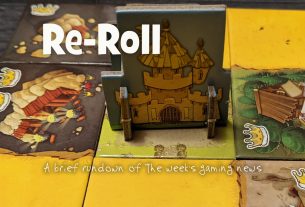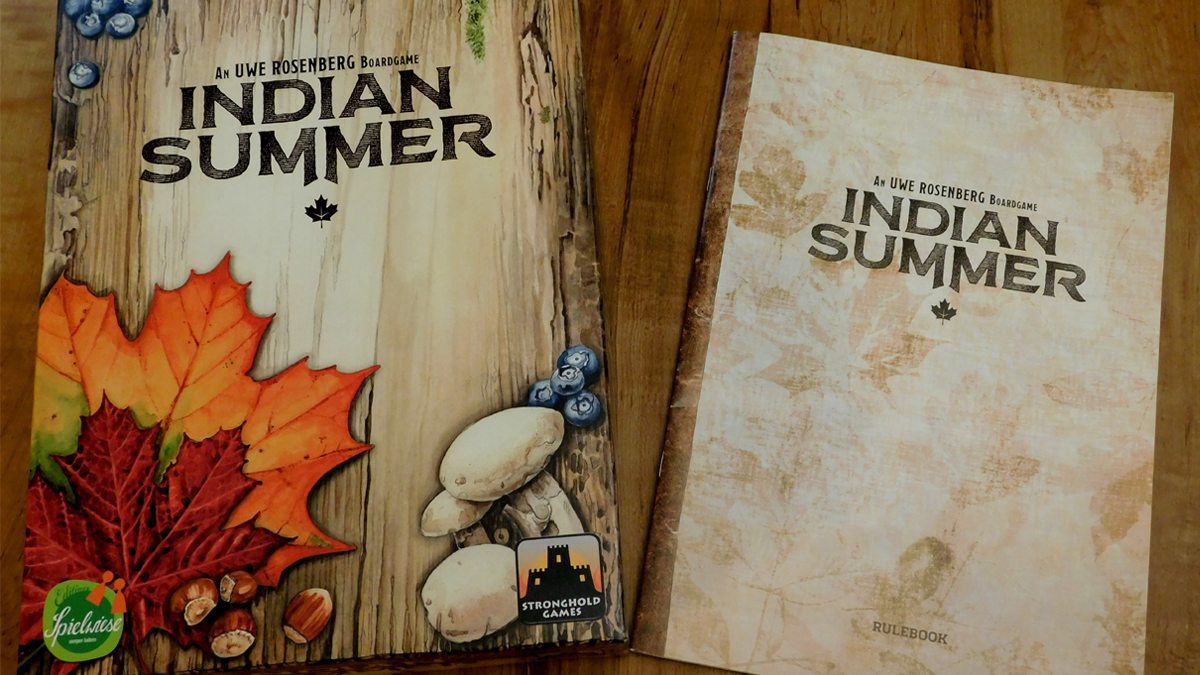
Sometimes a game grabs you by the shoulders and demands to be played—marauding barbarians in Blood Rage, preparing the cosmos for colonization in Terraforming Mars, or even sewing together a quilt in Uwe Rosenberg’s earlier game, Patchwork.
Indian Summer, unlike everything I just mentioned, doesn’t scream to be picked up. It isn’t a game about war or exploration or zombies. Designed for 1–4 players ages 10 and up, Indian Summer ($59.95) is a game with the idiosyncratic theme of taking a gentle stroll through the forest one unseasonably-beautiful September. And, at a 15– 60-minute playtime that feels comparable to a nice walk, that setting suits it perfectly.
Indian Summer Components
The price tag for Indian Summer can be daunting, and perhaps seem high, but once you peel back the shrink wrap and find yourself faced with roughly a dozen heavy-duty punch-boards you’ll understand why.
The Stuff
- 2 Double-sided tile board pieces
- 6 Double-sided forest floor player boards
- 75 Leaf tiles in three colors (29 red, 29 yellow, and 17 green)
- 20 Animal tiles
- 32 Squirrel tokens (because what game is complete without a full complement of squirrels?)
- 4 Backpack player aids
- 1 Berry bush chit
- 1 Hiking shoes 1st player token
- 80 Treasure tokens (30 berries, 24 nuts, 18 mushrooms, and 8 feathers)
- A rulebook
The process of punching out piece-after-piece of forest leaves and furry animals would be a lot more tedious if the artwork and graphic design of the game wasn’t so charming. Vibrant colors leap off the cardboard to transport you into the warm and sunny world of Indian Summer, with chirping birds and curious squirrels.
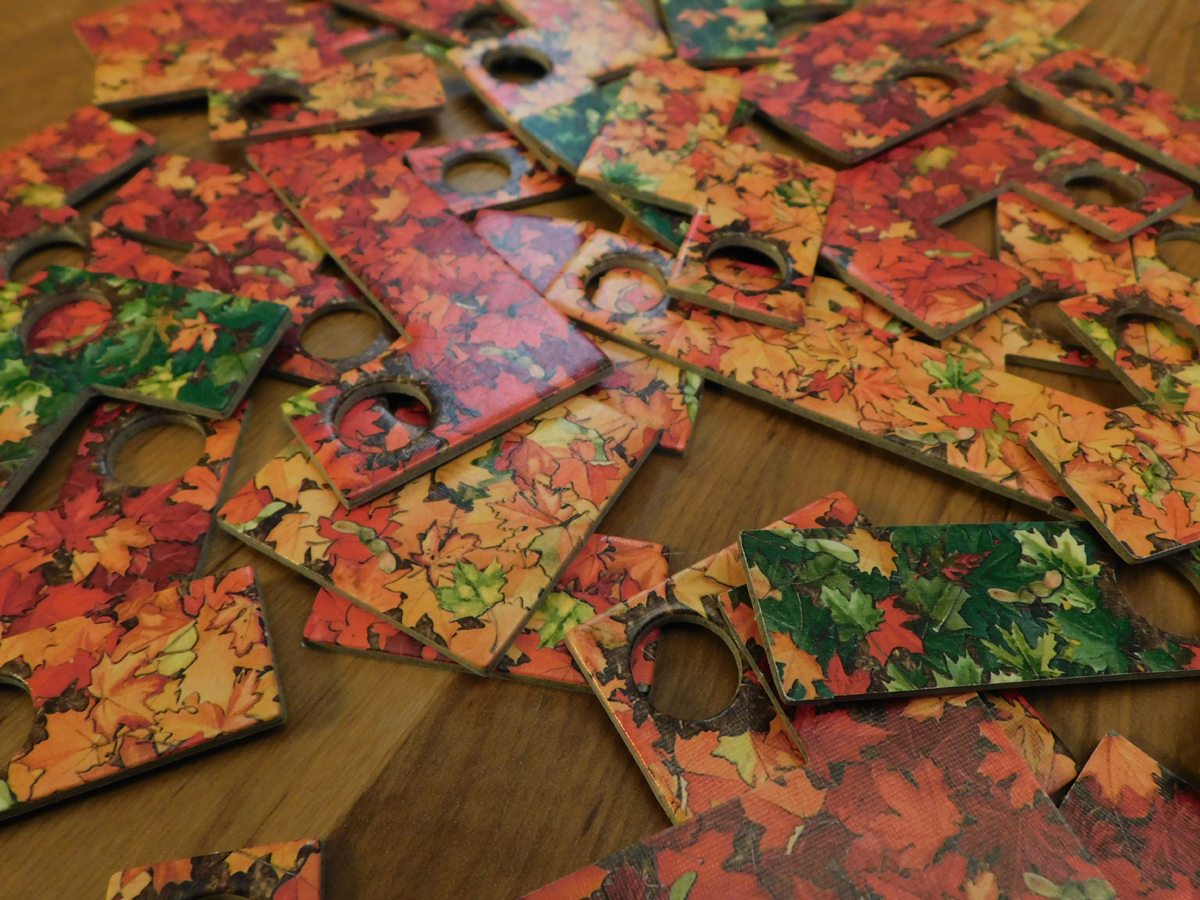
The warmth and wonder and beauty that’s wrapped up in this robust box is a smart move because it primes the pump, it softens you up, it makes you want to like the game before you even crack the rulebook open. Which is fine, because a game that does the opposite—that skimps on artwork and cuts corners on components (sometimes literally)—has the opposite effect, making it harder for a game to win you over even if, at its core, it’s quite good.
The Layout
The game lays out more simply than the mass of cardboard chits and tiles would indicate. Each player chooses a forest floor grid, a backpack, 5 leafs tiles, and a few power tokens. Two thin boards with the animal tiles are placed in the middle of the play area and the animal tiles are stacked on top of them (it’s worth noting here that the animal tokens are almost hypnotically cute), and then a handful of leaf tiles are spread in an oval around it. And from there, you’re ready to play.
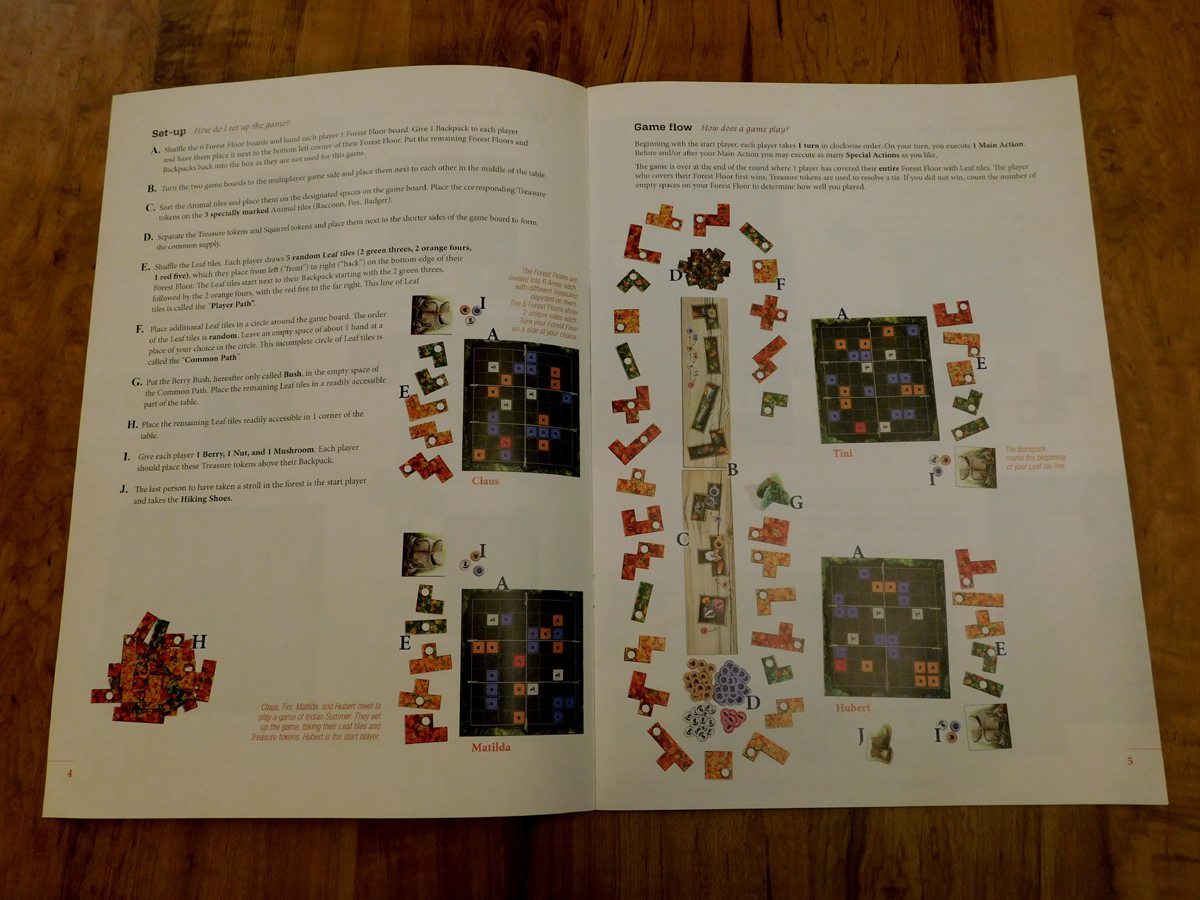
How to Play Indian Summer
The goal in Indian Summer is a simple one: be the first player to perfectly cover your forest floor. There are no victory points, no currency, and in fact no scoring system of any kind. This is a race, plain and simple, winner-take-all.
Main Actions
On your turn, you have two Main Actions to choose from. First, you can take one of the leaf tiles from your supply and place it on your player board (note: if this was your last remaining leaf tile, then you refill your supply from the tiles laid out in the center, keeping a close eye on what’s coming up that you may want). However, if you don’t like your options, or you’ve just backed yourself into a geometric corner, then you can choose to not play any leaf tiles and instead place a squirrel token.
Squirrel tokens are small, taking up only a single spot on your grid, but as such, they can fit anywhere. Sometimes you’ll have left yourself odd little gaps in your board, which leaves your squirrel friends as the only option to patch it up and continue on towards victory.
These—place a leaf or place a squirrel—are your two main actions, and while they’re important, they are actually secondary to the meat of the game: Special Actions. You may recall seeing 80 Treasure tokens listed in the game’s contents: berries, nuts, mushrooms, and feathers. Each of these allows a player to take a different, unique action. Some of these supplement your Main Action, allowing you to do more in a single turn and make great leaps towards your goal of covering the forest floor. Others will be Alternative Main Actions, which replace your mundane options with something far more powerful.

Special Powers
These bonuses have a hierarchy, with each being more valuable and useful than the next. As such, you can save up cheaper tokens and trade them in for more powerful ones, creating a mini-market system that serves as almost a game-within-a-game as you try to decide whether you want to use 2 berries or trade them in for 1 nut. Before I explain how you earn treasures (apart from the scant few you begin the game with), let’s take a look at what each individual Treasure will do.
- Berry: The most common of the Treasures, cashing in a Berry token is a supplemental action that allows a player to immediately refill their leaf supply to a full 5. This comes in most handy when you see a specific shape you need coming up and realize your opponent will be refilling his supply before you. The berry lets you short-circuit that order and get the piece(s) you need.
- Nut: Another supplemental action, redeeming the Nut allows a player to take and place a Squirrel token from the reserve onto their board. This lets you fill in the nooks and crannies you’ve left yourself without having a squander a whole turn by using your Main Action to take a squirrel. Even though this is low on the Treasure value chain, it’s a very useful ability.
- Mushroom: Using the Mushroom is an Alternative Action, taking the place of your Main Action. Using a Mushroom lets you place two leaves instead of one. The first comes from the leaves in the middle, and the second is stolen from your opponent. So not only does this double the amount you can play in a turn, it also adds an element of “take that” as you wait to steal the precise piece your opponent needs most.
- Feather: The most valuable of the Treasures, this is the other Alternative Action, and it simply allows you to place 2, instead of 1, leaf tiles from your supply onto your board. This not only gives you additional speed in the race to fill in your board, it allows you the most freedom to choose the shapes that will be most useful at any given time. And choosing the right shapes is critical.
These Treasures provide the essence of the game. You will find yourself storing them up like, dare I say, a squirrel in winter, so you can unleash a series of massively-productive turns that slingshot you into the lead. Because, while you’re only allowed one primary action (whether it’s Main or Alternate) per turn, you can play as many Nuts and Berries each turn as you want. So sometimes the cheaper bonuses become better because you can cram more into a turn. Don’t want to wait to get the right leaf tile? Throw down 5 Nut tokens and summon a Squirrel army!
So the real question then becomes: How do you get more Treasure?
The Player Board
Each player board starts with a random assortment of Treasure symbols strewn out across the forest floor. Each board is also subdivided into 6 smaller 3×4 sections. These Treasure symbols that litter your board are the reason each of the leaf tiles has a hole in it. In order to earn more Treasure, you will first need to make sure that you can see it.
While it’s perfectly acceptable to cover up these bonuses, you will then be missing out on the fuel that propels you onward. While covering up some of these is inevitable, you will want to work hard to line as many of them up with the holes in your leaf tiles as possible. Each time you place a leaf tile that still reveals a Treasure symbol, you take the corresponding token from the reserve and place it over the hole. This is a reminder that you have the potential to earn this Treasure, although you haven’t yet.
You don’t actually earn these bonus tokens until you complete one of your mini-grids. As soon as you fill in one of the 3×4 grids you immediately take all the Treasure tokens from that grid and add them to your supply. So, in a virtuous cycle, the more bonuses you spend the faster you can earn new ones.

But, if contorting your leaves to earn Treasure without making your board too convoluted wasn’t hard enough, Uwe Rosenberg throws in one final way to earn even more treasure, a tantalizing little mechanic that will take up far more of your headspace than it should as you sacrifice your whole strategy just to earn more.
Animal Tiles
In the center of the board are 7 different shapes of Animal Tiles, with varying quantities of each. The largest (badger, fox, raccoons) only have one tile (and give an additional Treasure token when taken), while simpler, smaller shapes can be taken multiple times (snakes, butterflies, etc). These tiles can be taken and placed anytime, but only if you can place them entirely across holes in your other tiles. So, in addition to trying to make sure your leaf openings are showing Treasure, you have the added goal of making sure those openings align to form any of the shapes of the Animal Tiles. Because after you finish your mini-grid and harvest your goodies, if you can place an animal tile over proper openings, you then get any Treasure tokens that show through those holes again.
So imagine for a moment you’ve managed to create a 2×2 grid of openings. 3 of those showed treasure: a berry, a nut, and a mushroom. You’ve finished those segments of forest floor, allowing you to harvest those Treasures. So now you can claim the Badger token, place it over those openings, and get an additional berry, nut, and mushroom. Boom.
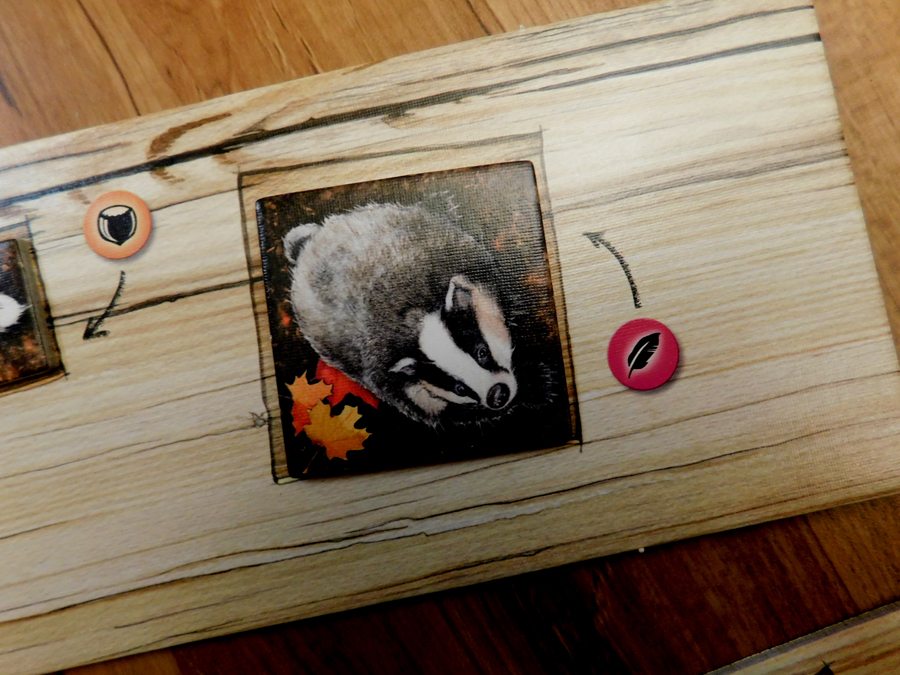
As you may have surmised, this can be a game-changer. These bonuses are powerful, and doubling them can swing a game in your favor. However, that’s easier said than done. You will find yourself obsessing and head-scratching over how to arrange your tiles not to win, not even always to earn immediate treasure, but to allow you to claim an animal tile and double your bonuses. Because it’s satisfying. It’s so difficult to do that it must be worth doing. Or is it?
I feel like Uwe Rosenberg is teasing us, at times, dangling the notion of that perfect move so tantalizingly in front of us that we abandon our safe, simple strategy to chase after that fox. If you’re clever, and also a little lucky, it may pay off for you. More often, though, you will find yourself sacrificing your strategy, compromising your tile placement and making the ever-maddening gaps in your board just so you can make that elusive “perfect move.”
But while it feels like he’s toying with us a little, subverting our expectations of what a game should be, it serves to make the game much richer than it may, at first blush, have seemed.
Should You Buy Indian Summer?
Indian Summer has big shoes to fill. In 2014 Rosenberg released his 2-player game Patchwork, in which players lay Tetris-shaped tiles to try to make the biggest quilt. That game was a veritable masterclass of substance and elegance, and as Rosenberg continues to explore this genre he can’t escape comparison to his own seminal work. Fortunately, Indian Summer brings enough new to the table that there’s room in your collection for both.
In his previous games, Rosenberg forced you to compete for points, to calculate your position constantly, and to make meticulous, mathematical plans. By removing any semblance of scoring and making Indian Summer a race, he’s fundamentally altered the way you have to approach the game. You can’t build an engine here because nothing that you build is going to be used more than once. Instead of making something that will pay out through elegance and ingenuity, here your strategy is almost of the push-your-luck variety.
You can see what benefits you the most on the board, but rarely does that coincide with how you want to arrange your tiles. So you bargain and lie, telling yourself that it’ll be okay, just sacrifice your placement to get that feather and everything will be okay. And it might. Or you might back yourself into a corner where you’ve spread yourself so thin trying to earn Treasure that, in fact, you haven’t earned any at all because you can’t harvest.
There’s nothing especially difficult in Indian Summer. It’s a game I would be perfectly comfortable playing with a 6-year-old because there’s nothing hidden or subtle. Rather, it’s a game of bold moves and daring gambits, and one which a younger player may excel at, where someone who has the burden of playing more games will shoot themselves in the foot by planning too much. So if you fancy yourself quite the strategist, always the best at Scythe or Lisboa or Food Chain Magnate, then watch out. This game might just be simple enough to outsmart you.
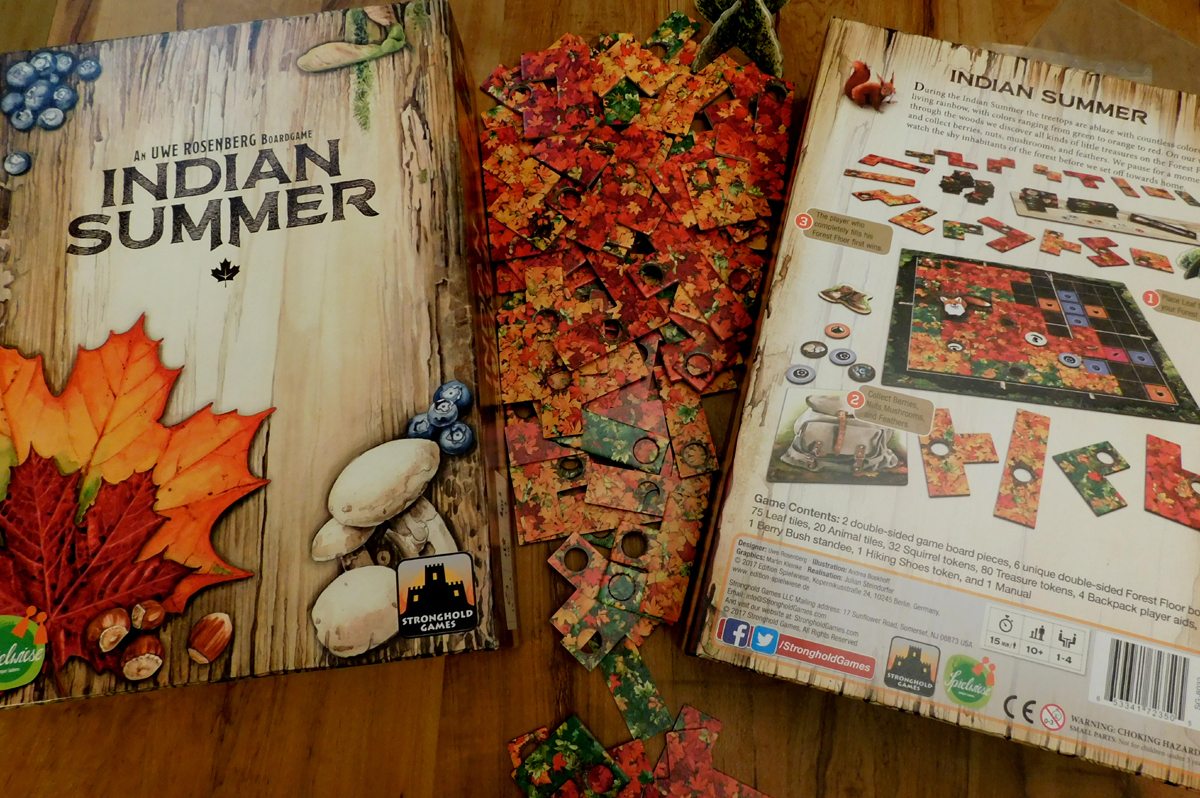
Click here to see all our tabletop game reviews.
If you’d like to stay up-to-date with all of our tabletop gaming coverage, please copy this link and add it to your RSS reader.



